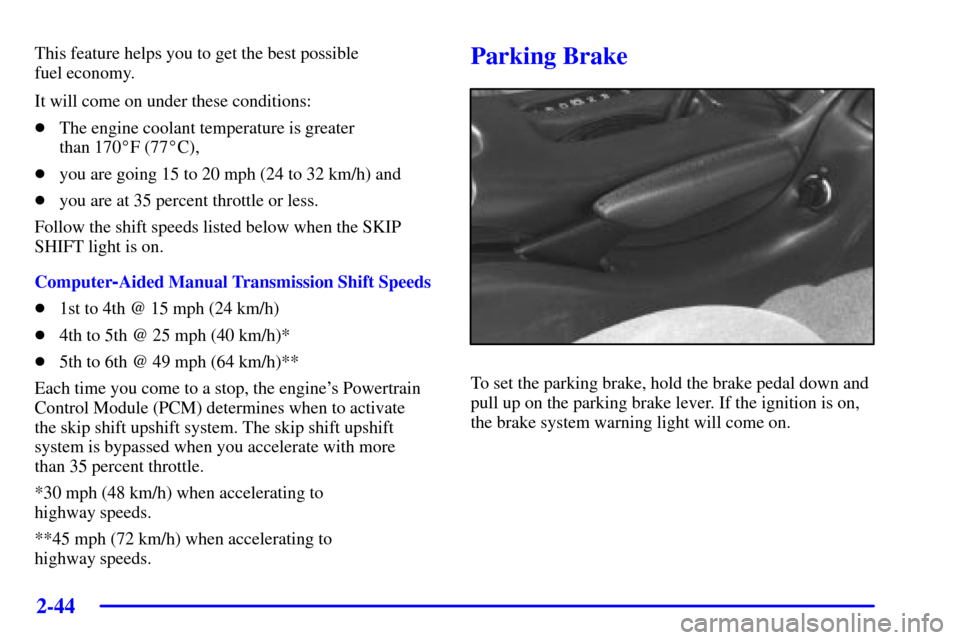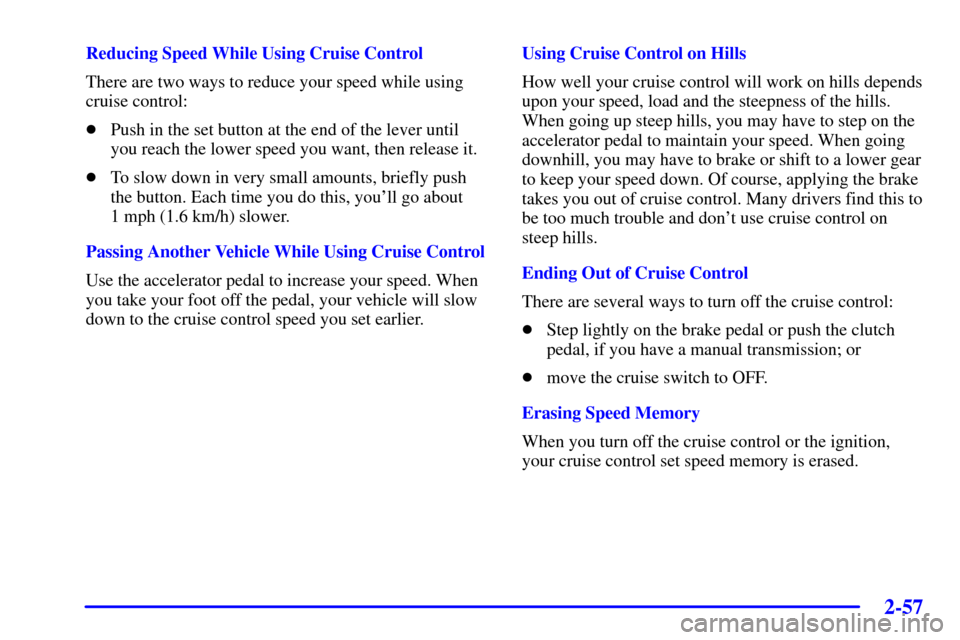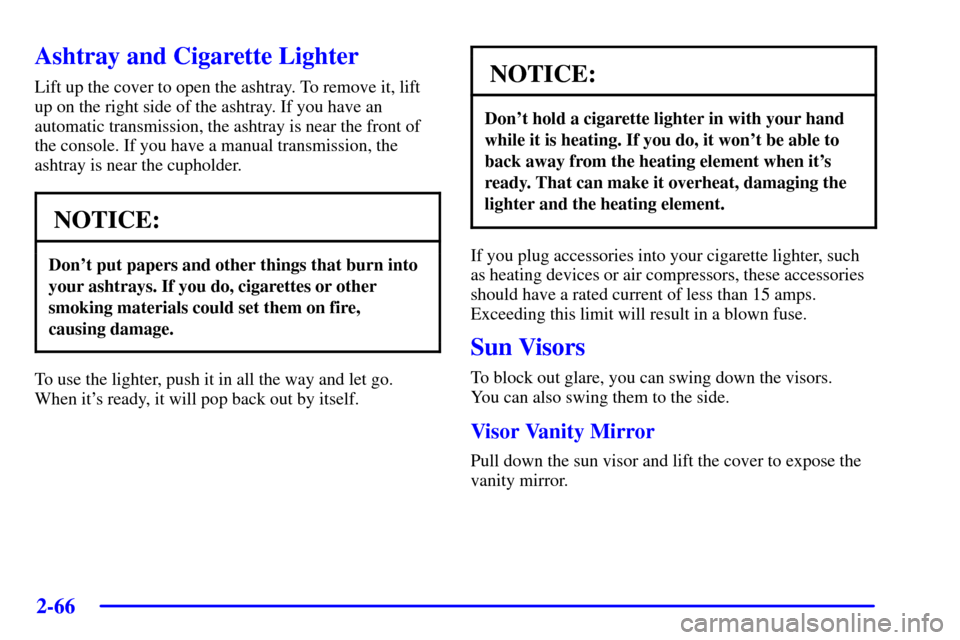Page 94 of 356

2-41
Six-Speed
This is the shift pattern
for the six
-speed
manual transmission.
Here's how to operate your transmission:
FIRST (1): Push the clutch pedal and shift into
FIRST (1). Then, slowly let up on the clutch pedal
as you press the accelerator pedal.
You can shift into FIRST (1) when you're going less
than 20 mph (30 km/h). If you've come to a complete
stop and it's hard to shift into FIRST (1), put the shift
lever in NEUTRAL and let up on the clutch. Press the
clutch pedal back down. Then shift into FIRST (1).SECOND (2): Press the clutch pedal as you let up
on the accelerator pedal and shift into SECOND (2).
Then, slowly let up on the clutch pedal as you press the
accelerator pedal.
THIRD (3), FOURTH (4), FIFTH (5) and
SIXTH (6): Shift into THIRD (3), FOURTH (4),
FIFTH (5) and SIXTH (6) gear the same way you do
for SECOND (2). Slowly let up on the clutch pedal as
you press the accelerator pedal.
To stop, let up on the accelerator pedal and press the
brake pedal. Just before the vehicle stops, press the
clutch pedal and brake pedal, and shift to NEUTRAL.
NEUTRAL: Use this position when you start or idle
your engine.
Page 95 of 356
2-42
REVERSE (R): To back up, push down the clutch
pedal and shift into REVERSE (R). Let up on the clutch
pedal slowly while pressing the accelerator pedal. If you
shift from SIXTH (6) into REVERSE (R), the shift lever
must be first placed in the NEUTRAL position centered
between SECOND (2) and THIRD (3) prior to shifting
into REVERSE (R).
Your six
-speed manual transmission has a feature that
allows you to safely shift into REVERSE (R) while the
vehicle is rolling at less than 5 mph (8 km/h).
If you have turned your ignition off and want to
park your vehicle in REVERSE (R), you will have to
move the shift lever quickly to the right, then forward
into gear.
Shift Speeds
CAUTION:
If you skip a gear when you downshift, you could
lose control of your vehicle. You could injure
yourself or others. Don't shift down more than
one gear at a time when you downshift.
This chart shows when to shift to the next higher gear
for best fuel economy.
Page 97 of 356

2-44
This feature helps you to get the best possible
fuel economy.
It will come on under these conditions:
�The engine coolant temperature is greater
than 170�F (77�C),
�you are going 15 to 20 mph (24 to 32 km/h) and
�you are at 35 percent throttle or less.
Follow the shift speeds listed below when the SKIP
SHIFT light is on.
Computer
-Aided Manual Transmission Shift Speeds
�1st to 4th @ 15 mph (24 km/h)
�4th to 5th @ 25 mph (40 km/h)*
�5th to 6th @ 49 mph (64 km/h)**
Each time you come to a stop, the engine's Powertrain
Control Module (PCM) determines when to activate
the skip shift upshift system. The skip shift upshift
system is bypassed when you accelerate with more
than 35 percent throttle.
*30 mph (48 km/h) when accelerating to
highway speeds.
**45 mph (72 km/h) when accelerating to
highway speeds.
Parking Brake
To set the parking brake, hold the brake pedal down and
pull up on the parking brake lever. If the ignition is on,
the brake system warning light will come on.
Page 101 of 356

2-48
Shifting Out of PARK (P)
(Automatic Transmission Only)
Your vehicle has an automatic transmission shift lock
control system. You have to fully apply your regular
brake before you can shift from PARK (P) when the
ignition is in RUN. See ªAutomatic Transmission
Operationº in the Index.
If you cannot shift out of PARK (P), ease pressure on
the shift lever
-- push the shift lever all the way into
PARK (P) and release the shift lever button as you
maintain brake application. Then press the shift lever
button and move the shift lever into the gear you wish.
If you ever hold the brake pedal down but still can't
shift out of PARK (P), try this:
1. Turn the ignition key to OFF.
2. Apply and hold the brake until the end of Step 4.
3. Shift to NEUTRAL (N).
4. Start the engine and then shift to the drive gear
you want.
5. Have the vehicle fixed as soon as you can.
Parking Your Vehicle
(Manual Transmission Models Only)
Before you get out of your vehicle, move the shift lever
into REVERSE (R) and firmly apply the parking brake.
Once the shift lever has been placed into REVERSE (R)
with the clutch pedal pressed in, you can turn the
ignition key to OFF, remove the key and release
the clutch.
If your vehicle is equipped to tow a trailer, see ªTowing
a Trailerº in the Index.
Page 107 of 356
2-54 Windshield Washer
There is a paddle with the word PUSH on it at the top
of the turn signal/multifunction lever. To spray washer
fluid on the windshield, push the paddle. The washer
will continue to spray until you release the paddle. The
wipers will clear the window and wipe a few more times
before stopping or returning to the previous setting.
See ªWindshield Washer Fluidº in the Index.
CAUTION:
In freezing weather, don't use your washer until
the windshield is warmed. Otherwise the washer
fluid can form ice on the windshield, blocking
your vision.
Cruise Control (Option)
With cruise control, you can
maintain a speed of about
25 mph (40 km/h) or more
without keeping your foot
on the accelerator.
This can really help on long trips. Cruise control does
not work at speeds below about 25 mph (40 km/h).
When you apply your brakes or push the clutch pedal
(manual transmission) the cruise control shuts off.
Page 110 of 356

2-57
Reducing Speed While Using Cruise Control
There are two ways to reduce your speed while using
cruise control:
�Push in the set button at the end of the lever until
you reach the lower speed you want, then release it.
�To slow down in very small amounts, briefly push
the button. Each time you do this, you'll go about
1 mph (1.6 km/h) slower.
Passing Another Vehicle While Using Cruise Control
Use the accelerator pedal to increase your speed. When
you take your foot off the pedal, your vehicle will slow
down to the cruise control speed you set earlier.Using Cruise Control on Hills
How well your cruise control will work on hills depends
upon your speed, load and the steepness of the hills.
When going up steep hills, you may have to step on the
accelerator pedal to maintain your speed. When going
downhill, you may have to brake or shift to a lower gear
to keep your speed down. Of course, applying the brake
takes you out of cruise control. Many drivers find this to
be too much trouble and don't use cruise control on
steep hills.
Ending Out of Cruise Control
There are several ways to turn off the cruise control:
�Step lightly on the brake pedal or push the clutch
pedal, if you have a manual transmission; or
�move the cruise switch to OFF.
Erasing Speed Memory
When you turn off the cruise control or the ignition,
your cruise control set speed memory is erased.
Page 119 of 356

2-66
Ashtray and Cigarette Lighter
Lift up the cover to open the ashtray. To remove it, lift
up on the right side of the ashtray. If you have an
automatic transmission, the ashtray is near the front of
the console. If you have a manual transmission, the
ashtray is near the cupholder.
NOTICE:
Don't put papers and other things that burn into
your ashtrays. If you do, cigarettes or other
smoking materials could set them on fire,
causing damage.
To use the lighter, push it in all the way and let go.
When it's ready, it will pop back out by itself.
NOTICE:
Don't hold a cigarette lighter in with your hand
while it is heating. If you do, it won't be able to
back away from the heating element when it's
ready. That can make it overheat, damaging the
lighter and the heating element.
If you plug accessories into your cigarette lighter, such
as heating devices or air compressors, these accessories
should have a rated current of less than 15 amps.
Exceeding this limit will result in a blown fuse.
Sun Visors
To block out glare, you can swing down the visors.
You can also swing them to the side.
Visor Vanity Mirror
Pull down the sun visor and lift the cover to expose the
vanity mirror.
Page 121 of 356
2-68
Floor Mats
Your vehicle's floor mats are custom-fitted to the floor
wells. Be sure the driver's floor mat is in place. If it
isn't, it could interfere with the accelerator pedal, brake
pedal or with the clutch pedal on manual transmissions.
T-Top Roof Panels (Option)
Removing the T-Top Roof Panels
CAUTION:
Don't try to remove the T-top panel while the
vehicle is moving. Trying to remove a T
-top panel
while the vehicle is moving could cause an
accident. The panel could fall into the vehicle and
cause you to lose control, or it could fly off and
strike another vehicle. You or others could be
injured. Remove the T
-top panel only when the
vehicle is parked.
1. The door key unlocks the T-top panels. The lock is
located over each door window. Turn the key
counterclockwise to unlock the panel.